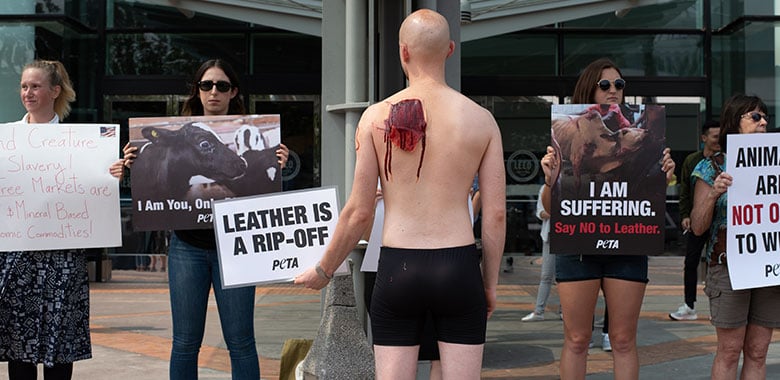These Videos Prove That Animals Suffer Worldwide for Leather
Six shocking PETA exposés have revealed the extreme suffering of animals killed for leather.
Video footage captured inside slaughterhouses shows that in at least nine countries on three continents one thing is true: Leather is always a bloody, deadly rip-off.
Millions of cows and other animals who are killed for their skin are trapped on extremely crowded farms where workers castrate and brand them and cut parts of their tails off—all without offering any pain relief. Most leather comes from countries such as Brazil, China, and India, where animal welfare laws are nonexistent or not enforced. Many animals are shipped across borders—and even seas or oceans—to be slaughtered in another nation. Because leather isn’t normally labeled, it’s very difficult to figure out where (or whom) it came from. Dogs are slaughtered for their flesh and skin in China, and their skin is mislabeled and sold around the world to unsuspecting consumers.

6 PETA Exposés Reveal a Global Network of Animal Suffering for Leather
In 2014, a deeply disturbing PETA Asia undercover investigation revealed that dogs in China were bludgeoned and killed so that their skin could be turned into leather gloves, belts, jacket collar trim, cat toys, and other accessories.
Every year, an estimated 2 million cows from India are bound, thrown onto trucks, and transported thousands of miles to Bangladesh to be slaughtered and skinned for leather. In 2015, PETA released video footage revealing that many of these cows were emaciated, exhausted, and so malnourished that they couldn’t stand up by the time they arrived. They had sustained broken tails and open, festering wounds.
A 2016 PETA video exposé featuring footage from Repórter Brasil revealed that workers in Brazil branded gentle cows and bulls on the face, electroshocked them, and beat them before finally slaughtering them so that their skin could be made into the leather interiors offered by the world’s largest car companies—including General Motors, Volkswagen, and Toyota.
The same year, PETA Asia obtained video footage captured inside a slaughterhouse in Cambodia showing workers repeatedly bashing cows over the head with sledgehammers before finally cutting their throats while still conscious. These sensitive animals’ skin is one of that country’s top exports, supplying the international leather industry.
In 2019, PETA Asia released disturbing eyewitness video footage shot inside a slaughterhouse in Thailand that offers a glimpse into the terror and pain inflicted on cows as they’re killed for leather and meat. The Thai meat industry produces 170,000 metric tons of cow flesh every year.
A 2020 Manfred Karremann investigation released by PETA Germany revealed the extreme cruelty endured by animals such as cows and sheep in the leather trade. The investigation found that animals are shipped on long, grueling journeys to locations halfway around the globe before being killed for leather. During transport, they’re exposed to the elements and denied sufficient food and water and they can fall and be trampled to death. Injured and dying animals are often illegally slaughtered, and that includes those who are pregnant.
More Facts About Leather
Consumers around the world are recognizing that it’s unacceptable to breed, abuse, and kill animals to make clothing—and that buying animal-based leather contributes to the climate catastrophe.
As a coproduct of the meat industry, leather made from cows’ skin shares responsibility for the greenhouse gas emissions, water pollution, water depletion, and deforestation caused by animal agriculture.
Turning animals’ skin into leather—a process known as “tanning”—requires massive amounts of energy and dangerous chemicals, including mineral salts, formaldehyde, coal-tar derivatives, and various oils, dyes, and finishes, some of them cyanide-based. Even the tanning industry admits that regardless of the tanning method used, animal-derived leather does not effectively biodegrade.
For every leather item purchased, an animal was sentenced to a lifetime of suffering. Conscientious consumers can choose from hundreds of styles of vegan leather shoes, jackets, belts, bags, and wallets. Check out PETA’s animal-friendly clothing guide for great tips on finding stylish and compassionate fashions:
You can make a difference and help reduce the number of animals killed for fashion today.
The biggest actions you can take are buying and wearing vegan clothes, and the “Living” section of PETA’s website is filled with tips to help you make your closet animal-friendly. If you want to be an all-star for animals, there are tons of ways to get more involved: Follow PETA on Facebook, X (formerly Twitter), Instagram, TikTok, and YouTube to stay up to date on our latest campaigns; subscribe to PETA News to get weekly updates on our efforts; and be sure to take action on the PETA action alerts and pledges below, which can be completed with the quick click of a button.
Take Action for Animals in the Leather Industry
There are multiple opportunities to help. As soon as you complete one action below, another will appear in its place. Just enter your information once. Then, keep clicking the “Send Message” button until you’ve completed every action.
